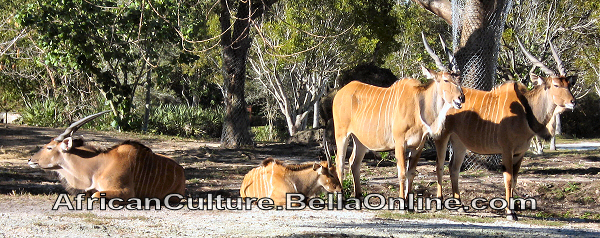Western Giant Eland Facts

Name: Western Giant Eland, Western Derby Eland
Scientific Name: Boselaphus derbianus derbianus
African Names: Mhofu (Shona), Pofu (Swahili), Phôhu (Tswana), Impofu (Zulu)

Height: 59 to 69 inches and a body length of 86.5 to 114 inches.
Average Adult Weight: 970 to 2000 pounds
Life Span: Up to 25 years
Description: Their coat is a ruddy fawn to chestnut color. Some males have a bluish tint to their coat. The Western Giant Eland has nine to seventeen vertical white stripes on its flanks. Their horns spiral loosely and can be 31.5 to 48.5 inches.
Habitat: Savannah woodland
Countries found in: Historically in Senegal, Gambia, Guinea-Bissau, Mali, Sierra Leone, Ivory Coast, Togo and Ghana. Now only found in Senegal. The last surviving population is protected in the Niokolo-Koba National Park in Senegal.
Babies: The gestation period for the Giant Eland is 9 months with one baby born. Mating occurs during the wet season. Males compete using their horns for dominance. The dominant male will mate with several females.
Food: Leaves, shoots, and fruits of woody plants.
Group Name: Herd. A typical herd contains 20 or more females and their calves. Adult males prefer to live alone.
Habits: Giant Eland are highly nomadic with a large home range. They are nocturnal and generally rest during the heat of the day. Giant Eland prefer to eat in the morning and evening while it is cool. They are very good jumpers jumping up to a height of alomst 5 feet. They can also run up to speeds of 43 miles per hour.
Conservation Status: Criticially Endangered. Approximately 200 left in the wild. Populations have declined because of excessive hunting, habitat destruction for farming, and disease.
Predators: Lion, spotted hyena and leopards
Interesting Facts: The Giant Eland is the world's largest antelope.
Scientific Name: Boselaphus derbianus derbianus
African Names: Mhofu (Shona), Pofu (Swahili), Phôhu (Tswana), Impofu (Zulu)

Height: 59 to 69 inches and a body length of 86.5 to 114 inches.
Average Adult Weight: 970 to 2000 pounds
Life Span: Up to 25 years
Description: Their coat is a ruddy fawn to chestnut color. Some males have a bluish tint to their coat. The Western Giant Eland has nine to seventeen vertical white stripes on its flanks. Their horns spiral loosely and can be 31.5 to 48.5 inches.
Habitat: Savannah woodland
Countries found in: Historically in Senegal, Gambia, Guinea-Bissau, Mali, Sierra Leone, Ivory Coast, Togo and Ghana. Now only found in Senegal. The last surviving population is protected in the Niokolo-Koba National Park in Senegal.
Babies: The gestation period for the Giant Eland is 9 months with one baby born. Mating occurs during the wet season. Males compete using their horns for dominance. The dominant male will mate with several females.
Food: Leaves, shoots, and fruits of woody plants.
Group Name: Herd. A typical herd contains 20 or more females and their calves. Adult males prefer to live alone.
Habits: Giant Eland are highly nomadic with a large home range. They are nocturnal and generally rest during the heat of the day. Giant Eland prefer to eat in the morning and evening while it is cool. They are very good jumpers jumping up to a height of alomst 5 feet. They can also run up to speeds of 43 miles per hour.
Conservation Status: Criticially Endangered. Approximately 200 left in the wild. Populations have declined because of excessive hunting, habitat destruction for farming, and disease.
Predators: Lion, spotted hyena and leopards
Interesting Facts: The Giant Eland is the world's largest antelope.
This site needs an editor - click to learn more!
You Should Also Read:
Greater Kudu Facts
Addax Facts
African Antelope & Gazelle
Related Articles
Editor's Picks Articles
Top Ten Articles
Previous Features
Site Map
Content copyright © 2023 by Jeanne Egbosiuba Ukwendu. All rights reserved.
This content was written by Jeanne Egbosiuba Ukwendu. If you wish to use this content in any manner, you need written permission. Contact
BellaOnline Administration
for details.


